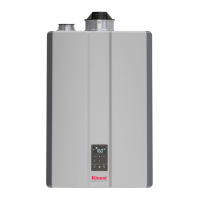Rinnai I-Series Condensing Boiler Combi Manual 17
Contaminant Maximum Level
Total Hardness Up to 200 mg/L
Aluminum * Up to 0.2 mg/L
Chlorides * Up to 250 mg/L
Copper * Up to 1.0 mg/L
Dissolved Carbon Dioxide
(CO2)
Up to 15.0 mg/L
Iron * Up to 0.3 mg/L
Manganese * Up to 0.05 mg/L
pH * 6.5 to 8.5
TDS (Total Dissolved
Solids) *
Up to 500 mg/L
Zinc * Up to 5 mg/L
Consideraon of care for your boiler should
include evaluaon of water quality.
• The water must be potable, free of
corrosive chemicals, sand, dirt, or other
contaminants.
• It is up to the installer to ensure the
water does not contain corrosive
chemicals or elements that can aect or
damage the boiler.
• Water that contains chemicals
exceeding the levels below can damage
the boiler.
* Source: Part 143 Naonal Secondary Drinking Water Regulaons
When choosing an installaon locaon, you
must ensure that clearances will be met and
that the vent length will be within required
limits. Consider the installaon
environment, water quality, and need for
freeze protecon. Requirements for the gas
line, water lines, electrical connecon, and
condensate disposal can be found in their
respecve installaon secons in this
manual.
This secon provides informaon on the
importance of water quality to the Rinnai
Condensing Boiler. The informaon is
intended to serve as general guidelines only
and is not a complete list of water quality
guidelines.
• Unsuitable heang system water can cause
the formaon of scale or sludge, which
aects system eciency. It can also cause
corrosion and reduce life of the heat
exchanger.
• Never use water that has been treated by a
reverse osmosis, deionized, or dislled
water to soen the water to ll the heang
system.
• For Domesc Hot Water systems, if you
install the boiler in an area that is known to
have hard water or that causes scale build-
up, the water must be treated and may
require a more frequent ushing schedule.
Scale build-up is caused by hard water and
can be accelerated if the boiler is set at a
high temperature. Rinnai oers
Southeastern Filtraon’s “ScaleCuer Water
Condioning System” that oers superior
lime scale prevenon and corrosion control
by feeding a blend of control compounds
into the cold water supply.
• Oxygen permeable or rubber tubing is not
permied in the heang system unless it is
separated from the boiler by a plate heat
exchanger.
• Thoroughly ush the system prior to lling.
While ushing, isolate the boiler.
• Do not introduce any system cleaner into
the boiler. Flush the system thoroughly to
remove all system cleaner before lling the
boiler with water.
• When freeze protecon of the heang
system is desired, only use Rinnai-approved
anfreezes. The allowed maximum
concentraon is 40%.
• Reference secon “14.1 Approved Cleaners,
Inhibitors and Anfreezes” in the Appendix
for an approved list of system cleaners,
inhibitors, and anfreezes.
IMPORTANT
Replacement of components due to
water quality damage is not covered by
the warranty.

